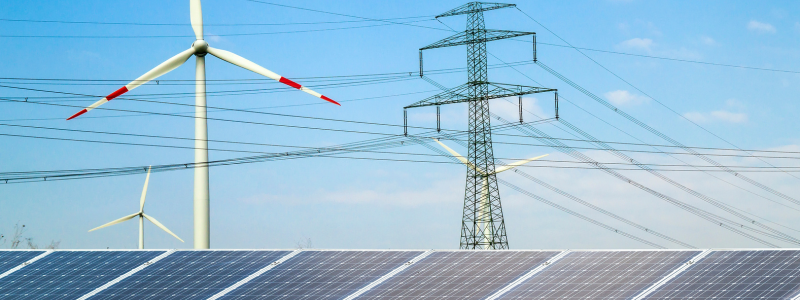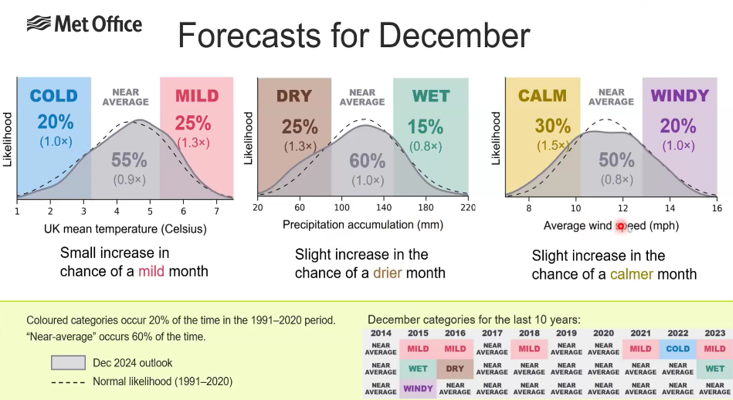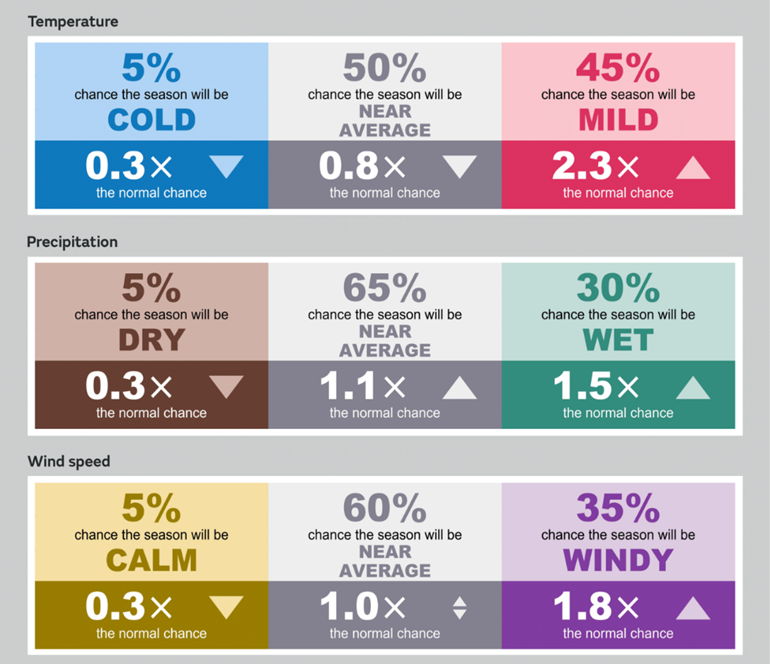

Seasonal Forecast Outlook for the Energy Sector 2024/25
The third iteration of the Royal Meteorological Society’s energy seasonal forecasting event was held on 28 November 2024. The free webinar, chaired by Ben Hutchins (University of Reading and RMetS Energy Science Engagement Fellow), focused on seasonal forecasts and how they are used by the energy sector.
Hazel Thornton (Met Office) provided an introduction to seasonal forecasts and outlined the upcoming winter outlook. Antje Weisheimer (ECMWF and University of Oxford) followed up on Hazel’s forecast with the perspective from the European Centre for Medium-Range Weather Forecasts. This was followed by two industry panellists who provided an overview of how they use seasonal forecasts: Lucy Field (AFRY consulting) and Isla Finney (Lake Street Consulting). The event attracted over 100 attendees from across the energy sector.
To watch the event recording, visit our YouTube channel.
Seasonal Forecasts and Drivers
Hazel Thornton began the event by presenting an outline of the variability in UK winters, which is in part driven by the variability of the North Atlantic Oscillation (NAO), a large-scale pressure pattern measured as the difference in pressure between Iceland and the Azores. More positive NAO conditions are associated with mild, wet, and stormy winters, while negative NAO conditions are associated with cold, dry, and calm winters.
Hazel described how NAO negative winters, such as the winter of 2009/10, can be particularly challenging for the energy sector, with high electricity demand and low wind power generation. She outlined that, while we have some confidence in seasonal predictions of the NAO, other large-scale climate patterns, such as the El Niño Southern Oscillation (ENSO) and the Quasi-Biennial Oscillation (QBO), can also influence the winter weather experienced in the UK through remote teleconnections.
The Outlook for the Upcoming winter
For the upcoming Winter, Hazel identified the following key predictions and their drivers:
- Mild temperatures in the UK, consistent with wider global warming trends.
- An increased likelihood of cool and still conditions during early winter due to below average (La Niña-like) temperatures in the tropical Pacific Ocean and an active Madden-Julian Oscillation (MJO), with the La Niña-like conditions also increasing the chance of milder and windier conditions during late winter.
- An increased likelihood of milder and windier conditions from the Atlantic as the Quasi-Biennial Oscillation (QBO) is in its westerly phase.
In summary, the combined result of the drivers outlined points towards a milder winter than average, with particularly mild and windy conditions during late winter.
A key message from the webinar was that a wide range of outcomes remain possible, despite agreement between different forecast systems.
For December, the Met Office system predicts an increased chance of a mild month (1.3x the normal chance) with dry (1.3x the normal chance) and calm conditions (1.5x the normal chance). This is consistent with the drivers outlined by Hazel. The shifted probability distributions are shown below.

Probability distributions for UK mean temperature, precipitation and wind speed, for December 2024. Source: Met Office, November 2024.
For the whole winter period, the forecast points to a mild, wet and windy winter, with a particularly strong signal for mild conditions (2.3x the normal chance). The probability distributions are shown in the figure below.

Probabilities that temperature, rainfall and wind speeds will be below-average, near-average, or above-average for the three months from December 2024 to February 2025. Source: Met Office, November 2024.
It was stressed that these statements are probabilistic: it remains possible that very different weather conditions could be experienced across the winter period, driven by rapidly changing conditions caused by a Sudden Stratospheric Warming, for example.
European Centre perspective
To build confidence in a seasonal forecast, alongside understanding of the physical drivers, the agreement between different forecast models must be considered. Antje Weisheimer followed Hazel’s talk by presenting on how we can build trust in the seasonal forecast for the winter based on:
- Past forecast skill.
- Known physical drivers and mechanisms.
- Comparison with previous similar winters.
Antje explained that, while there is a high degree of confidence for seasonal predictions of temperature in the North Atlantic, confidence is much lower for predictions of mean sea level pressure in this region, when considering the performance of past forecasts.
Antje finished by presenting two contrasting forecasts made for Winter 2020/21, a winter with similar physical drivers to the upcoming winter, specifically La Niña conditions with a westerly QBO phase, where:
- Global sea surface temperatures were well predicted.
- Although the forecast for mean sea level pressure showed a positive NAO state, consistent with the known physical drivers, the opposite was true with the winter showing a negative NAO state.
This example was presented to raise awareness that, while we do have confidence in the seasonal forecast, conditions can evolve rapidly during the winter to invalidate the forecast.
Overall, the outlook from ECMWF shows high agreement with the outlook from the Met Office, building confidence that we are likely to experience a mild winter, with a higher likelihood of mild and windy conditions in late winter.
How Seasonal Forecasts are used in the Energy Sector
We then heard from our other panellists, each giving an overview of how their organisation uses seasonal forecasts.
Lucy Field (AFRY consulting) provided context that, while the conditions experienced in Europe are important, the natural gas market is global, meaning that conditions in Brazil, the US, Japan, and China must also be considered. However, the seasonal outlook for Europe remains important, as low wind conditions in Europe can lead to increased gas-fired power generation and consequently increased UK gas prices.
While previous cold winters (e.g., 2018, 2021) have caused substantial depletion of European gas stores, the establishment of fill requirements (i.e., stores are not permitted to deplete below a specific capacity) and recent mild winters have meant that storage levels have only depleted to around 60% (rather than 20-30% in 2018/2021). As a result, the European gas network has remained resilient to conditions during recent winters and will likely continue to if the forecast winter turns out to be mild.
Isla Finney (Lake Street Consulting) described the multifaceted challenges of utilising seasonal forecasts in the energy industry. She emphasised the importance of considering forecast impacts beyond northwestern Europe, as the European electricity grid is interconnected, and European gas is connected to the rest of the world through the increasing liquefied natural gas market share. She also highlighted the importance of considering variables beyond temperature, such as wind speeds and solar, as renewable generation is expanding.
Isla outlined how perfect seasonal/decadal forecasts could enhance supply management and maintenance scheduling. Before using any seasonal forecast, she suggested checking how much skill it had shown historically and asking where the skill horizon falls. Isla noted that, while there is skill in some seasonal forecasts, skill over the mid-latitudes is limited, and so more focus is on short-to-medium range forecasts.
The session ended with a panel discussion and Q&A session. You can watch the full recording on our YouTube.
Future Events
We will continue to host events like this tailored to the energy sector. Stay up-to-date by signing up to our mailing list on this page.

